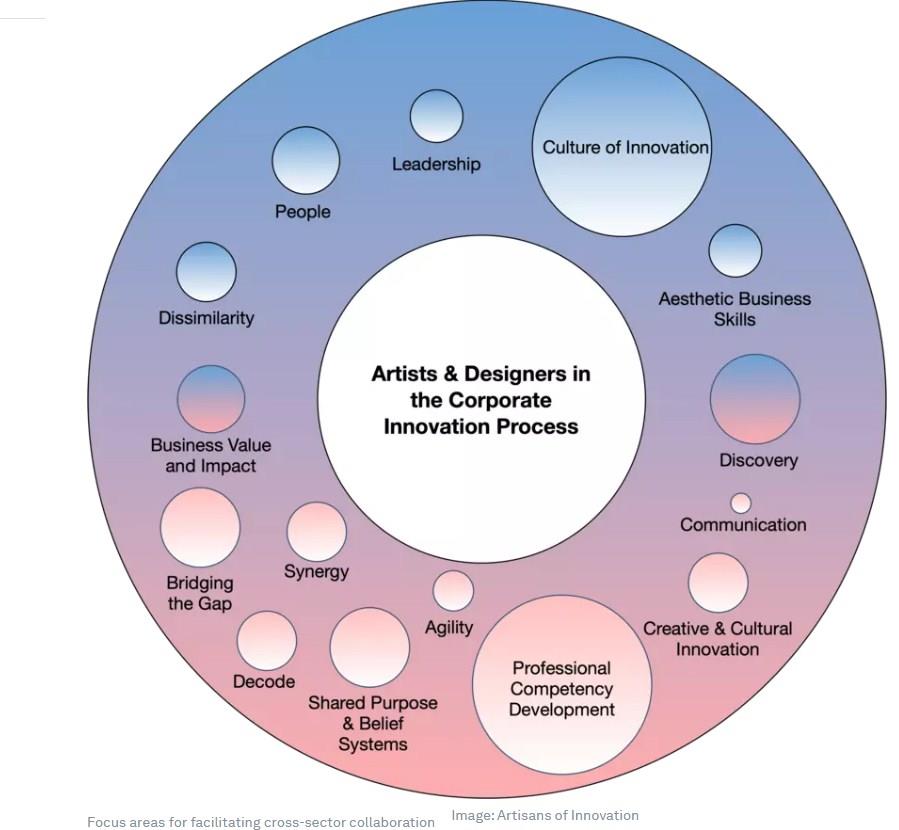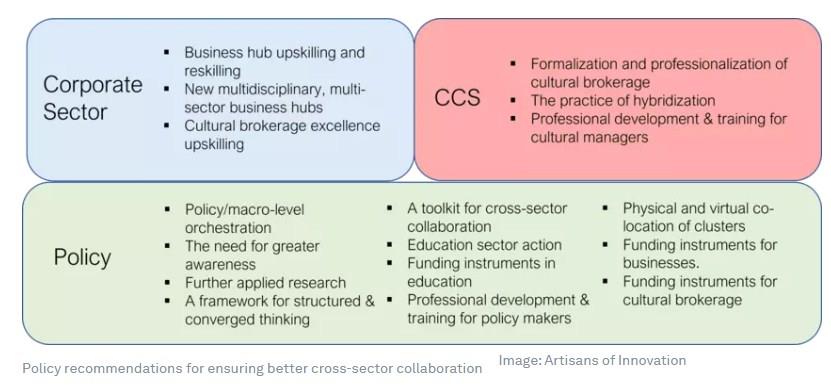by Johanna Kouzmine-Karavaieff and Khawar Hameed*
There is a fundamental disconnection between the corporate ecosystem and the culture and creative sectors (CCS), down to individual artists and designers themselves. But cross-sector collaboration can provide a way for creatives to provide innovative skills and strategies for business that can prove invaluable in today’s turbulent world. As we move into the Fourth Industrial Revolution, next-generation economies and a more networked society, the current disconnection risks haemorrhaging high-value human capital that can be used to build such a future.
Companies face challenges in a world of increasing volatility, uncertainty, complexity and ambiguity (VUCA), which they must overcome to survive and thrive. They need to be equipped and prepared with the skills and capability to do this. They need to pursue differentiation strategies and production processes that will enable them to provide innovative products and services that are aesthetically appealing, to innovate and transform in a responsive way at lower cost, and engage in experimental innovation that results in novel outcomes. The processes needed are not dissimilar to those on display in the CCS.
The CCS were experiencing high growth, but the shockwaves of the COVID-19 pandemic have had a catastrophic impact on these sectors. They were among the worst hit; a recent UNESCO report noted a total of 10 million jobs lost in these sectors worldwide in 2020. The shock has especially been felt in the performing arts (90% reduction in turnover), music (76% reduction in turnover), and the visual arts (38% reduction in turnover). Building back better and building back collectively through business model innovation is therefore essential.
Formalized, professionalized and orchestrated cross-sector collaboration between artists, designers and the corporate world would answer the problems and needs of both the corporate and culture sectors. It would stimulate business-model innovation and provide a basis for generating new skills that would allow the companies to thrive in the perpetually shifting VUCA world.
The artistic professions are permeated with VUCA due to the uncertainty of self-employment conditions in these sectors, and the inherent risk-taking nature of the creative process. They can provide transversal skills such as the ability to experiment, systems thinking, complex problem solving, and the creative process mindset. These help in dealing with VUCA-characterized situations by releasing the potential for more multi-dimensional creative solutions. Our analysis revealed a striking match between the workforce skills companies need to stay relevant in the future, and the skills and competencies artists and designers can bring.
Cross-sector business model innovation has immense potential to unlock the power of creative thinking. But the differences between different sectors’ beliefs, values, drivers, language and ways of thinking and acting need to be fully understood and harmonized for it be successful (though such differences can be experienced as a strength rather than discomfort). This is a precursor to establishing a culture of innovation resulting from cross-sector collaboration. Efforts have previously been made in this area, but there appears to be a significant lack of effective orchestration of practice that builds common ground. In our forthcoming report on cross-sector collaboration, we identified 15 themes that are important for this congruence:

These themes provide a basis for the CCS and the corporate sector, at all levels, to develop a framework and innovation ecosystem for cross-sector collaboration and workforce skills development.
Professional competency development is paramount in the corporate sector and among artists and designers to facilitate effective interaction between them. This includes fundamental aspects such as being able to identify points of interfacing between sectors; identifying relevant contacts and roles; understanding the nature of dialogue at different stages of the interfacing process; employing effective methods to engage in dialogue; and optimal points in time at which to interface and interact with artists and designers. Addressing these aspects in professional competency development is likely to increase the value of interaction and move engagement beyond just rhetoric and talk.
Cross-sector obstacles
Both the CCS and the corporate sector are currently being held back from effective cross-sector collaboration by existing belief systems and mindsets.
Artists open to using their skills and talent in other contexts need inspiration from role models who have understood and successfully addressed whys and hows of collaboration. There is currently a lack of visibility of such people with the community of practice and further afield. Meanwhile, on the side of business and industry, there appears to be a lack of well-defined and easily accessible guidance for collaboration with artists and designers.
At a government level, better policy instruments would help facilitate cross-sector collaboration. For it to work effectively, it is essential that orchestration of cross-sector collaboration is addressed at policy level and through macro-level programmes that facilitate practice at sectoral levels. We make 17 recommendations regarding this:

The full potential of cross-sector collaboration is unknown to most, even though the opportunity is immense, and the practice can provide systemic change. A concerted effort and focus on this would valorize the field of work, and also help strengthen the CCS in economic and other instrumental ways, such as creating new alternative labour markets for artists and designers who wish to adopt a hybrid approach in their profession. It would also help companies respond to challenges in the VUCA world by equipping them with the necessary human capital.
*Principal Consultant in Culture and Creative, Artisans of Innovation and Principal Consultant in Digital Innovation, Artisans of Innovation
**first published in: www.weforum.org




 By: N. Peter Kramer
By: N. Peter Kramer

